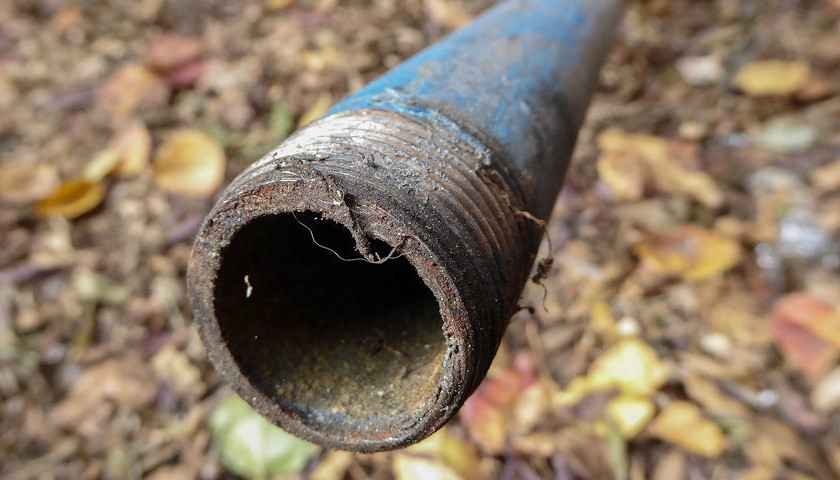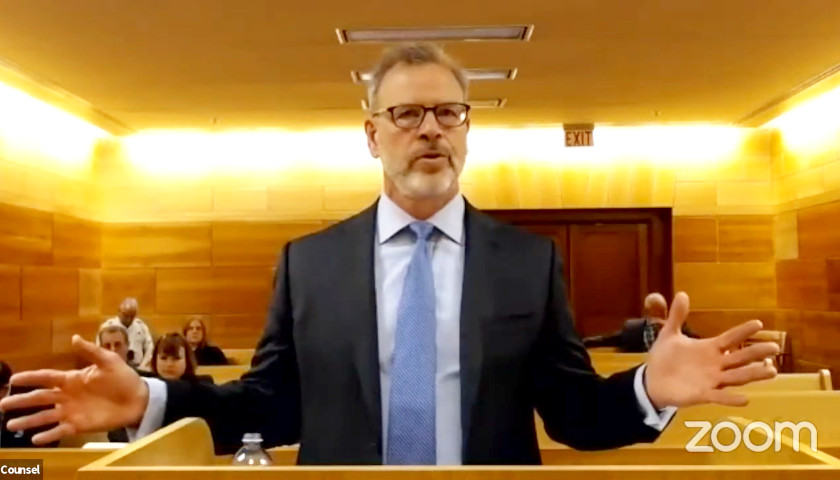Don Hauenstein is a Purple Heart Vietnam Veteran who spent a dozen years in the U.S. Marine Corps. He told The Ohio Star he’s never seen anything like the cloud of hazardous materials that hit his hometown nearly a month ago after a Norfolk Southern train carrying hazardous chemicals derailed.
Worse, the retired East Palestine, Ohio, resident said he and many of his fellow community members believe their government isn’t telling the truth about the dangers that exist.
“We don’t know what the impact will be over the years, just like we had with Agent Orange in Vietnam,” Hauenstein, 77, said in an interview this week from East Palestine’s American Legion Post. “The chemicals on that train, we don’t know how they’re going to act 10 years, 20 years down the road.”
“That’s what concerns me. I have a lot of friends here, most of them are younger than I am,” he added.
And the ones who want out of the cloud of uncertainty hanging over them may be stuck in a contaminated zone.
Several sources told The Star that question marks surround what has been a booming real estate market.
“With the news that’s come out, initially it’s going to have a big impact on housing values,” Maria Cocca Kurelko, a real estate agent with Howard Hanna Real Estate Services told The Times Leader in Wilkes-Barre, Pennsylvania.
“People are going to want to be assured that they’re going to be OK if they move into that house, and who can do that right now?” the 23-year veteran of home sales added.
Hauenstein said he talked about moving a while back. His wife didn’t want to at the time.
“Now it’s a different story,” he said. “What do we do with our condo now?”
‘Black Cloud’
There seem more questions than answers for the people of East Palestine, a village of about 5,000 people located in northeastern Columbiana County, near the Pennsylvania border.
They’ve been provided all kinds of assurances from Ohio Gov. Mike DeWine, the Environmental Protection Agency and other government bureaucrats that all is well with the water supply and air quality. That’s a tough sell for residents of a community at ground zero of the Feb. 3 50-car train derailment. Ten of those carriages were carrying hazardous materials. Hundreds of residents were forced to evacuate ahead of the February 6 “controlled release” of poisonous gasses that Norfolk Southern carried out.
Hauenstein says the photos of the mushroom-looking cloud hanging over East Palestine and the surrounding area don’t do the catastrophe justice.
“For days and days and days this thing just kept burning and burning, with a big black cloud hanging over your head. You could see it from a long way off,” he recalled. “When they lit it, it went straight up into the clouds and mushroomed out. It looked like a small atom bomb, without the noise.”
An analysis drawn from the EPA’s measurements of the toxic chemicals released shows at least nine of the dozens of chemicals being monitored could pose long-term problems for the area. Among them, acrolein, a chemical used to control rodents, plants, algae and microorganisms. It’s a clear liquid, it’s toxic and can cause inflammation and irritation of the skin, respiratory tract and mucous membranes, according to the US Centers for Disease Control and Prevention.
Many East Palestine-area residents have reported having coughs, bronchial issues, skin irritation, headaches and other health problems since the derailment and the controlled chemical release.
“It’s not elevated to the point where it’s necessarily like an immediate ‘evacuate the building’ health concern,” Dr. Albert Presto, an associate research professor of mechanical engineering at Carnegie Mellon’s Wilton E. Scott Institute for Energy Innovation told CNN. Presto is working on the university’s chemical monitoring effort in East Palestine. “But, you know, we don’t know necessarily what the long-term risk is or how long that concentration that causes that risk will persist.”
Troubled Waters
That uncertainty is on a lot of people’s minds these days, in and around East Palestine, particularly as government assurances of safe drinking water and air don’t seem to jibe with what’s happening on the ground.
Forestry workers have found that animals are dying at alarming rates. A source told The Star that her husband, a wildlife biologist and consultant for the federal Forest Service, received hundreds of calls on both Sunday and Monday from colleagues who say forestry workers have found hundreds of dead animals in Ohio’s parks.
Several labs across the country have received specimens of whole minks, deer, elk, worms and livers of such animals and they are finding toxicities that are off the charts, she said.
“These highly toxic levels are the exact chemicals that were released from East Palestine. Wayne National Forest and Shawnee State Forest in Ohio, are downriver from East Palestine and are two parks where samples are from,” she told The Star.
Multiple sources report that many of the myriad birds that populate the area’s creek and river valleys have seemed to disappear.
“We’re seeing very few birds are coming to our feeders now,” said Hauenstein, who is also a member of the East Palestine Sportsmen’s Club. Members have been finding “a lot of dead fish” in the club’s 3-acre lake, which was fully stocked a few years ago.
Ohio EPA is independently testing the municipal water supply in East Palestine weekly. The Division of Drinking and Ground Waters is collecting the samples at the East Palestine Water Plant, and shipping them to an independent lab for analysis.
U.S. Environmental officials this week said residential and outdoor air quality levels remained “normal” in East Palestine.
Beyond East Palestine
While the focus of concern, clean-up and remediation have been on a one-mile evacuation zone, worries extend well beyond East Palestine.
Cecelia Ader works at the Moose Lodge in East Palestine. She lives with her two teen-age sons in nearby Enon Valley, PA, about six miles northeast. While Ohio’s governor, U.S. Transportation Secretary Pete Buttigieg, former President Donald Trump, even environmental activist Erin Brockovich, have come to East Palestine, Ader said her community has been mostly forgotten.
“They’re not testing our water and we’re all on wells,” Ader told The Star.
Her home is not located in the evacuated zone, but she said she got her sons out as soon as they saw the plume of smoke overhead. With limited funds and feeling no hope for reimbursement, Ader said she had to go back home a short time later.
She said she and her children have been experiencing stomach issues, headaches, increased fatigue and other symptoms ever since.
“I took my oldest son to the doctor and the doctor said he is experiencing everything that others who have been exposed to the chemicals are saying they’re experiencing,” Ader said.
Bret Petrich, president of the Enon Valley Borough Council, felt the community had been forgotten until recently. He said there had been little information flowing from the powers-that-be into the little community of about 300 residents, many of whom live along the Norfolk Southern Railroad tracks.
In recent days, Petrich said, state officials, including Pennsylvania Governor Josh Shapiro’s office, have been reaching out.
“Now the information flow is being increased dramatically,” he told The Star. Representatives for the governor were in town Monday and said they’d be happy to help with whatever Enon Valley needed.
Still, Petrich said he knows of no direct financial assistance in the form of reimbursements being offered to the community at this point. The Pennsylvania Department of Health’s Health Resource Center has established clinical services, behavioral health support and other resources at the Darlington, PA, Municipal Building. The assessments will be conducted from 10 a.m. to 8 p.m. Feb. 28-March 3, and March 6-10, according to the EPA.
But the trust deficit remains, Petrich said.
“I’m always going to have concerns. There are a lot of unknowns. What’s the long-term effects?” he said. “A lot of it is trust in the government and I don’t know if the people fully have that.”
’Nothing but Goodness’
If there is a silver lining in the dark cloud hanging over East Palestine and the surrounding area, it’s another lesson in neighbor helping neighbor — and stranger helping stranger. “East Palestine Strong,” as the signs say.
“I feel so blessed right now. I know this is an uncertain time. People are worried. Some are moving. But I have had nothing but goodness come through this telephone over the last few weeks,” said Mallory Aponick, disaster services coordinator for the First Church of Christ on East Palestine’s Market Street.
Aponick said a woman from Orlando, FL, called and said she wanted to help. The woman and a couple of her co-workers then got in a car and drove 17 hours to personally deliver bottled water, paper towels and other supplies.
“People are calling and wondering what they can do,” Aponick said.
The people of East Palestine and the surrounding communities may be looking at a long road to recovery.
Hauenstein, who says he has lived much of his life in the area, said the future right now is so uncertain.
“It’s going to take a long time to get back where it was, if they can ever get back to where it was,” he said.
– – –
M.D. Kittle is the National Political Editor for The Star News Network.
Photo “Erin Brockovich” by Erin Brockovich.









Really would like to see a deep dig on the chemicals, like following up on the rumors of War chemical componets on board. All the drop off points for every car. Heading to eastern seaboard for oversea delivery…
Ukraine…not that I’m suspicious…
Remember 9/11 when that smoke lingered and we were all told it was safe…then we had first responders and people who worked to clear the site all getting cancers and dying! I lived in Jersey at that time and drove to see my mom in NY on Dec 8th for her birthday and smoke was still visible in high column…safe not!!!
How many can relocate?
Most of those people would need to sell their homes to relocate and there won t be any buyers!